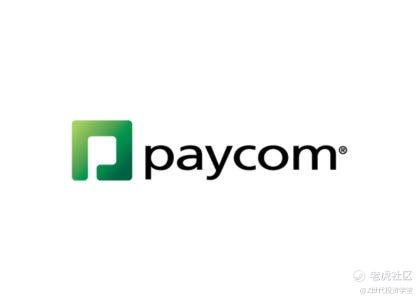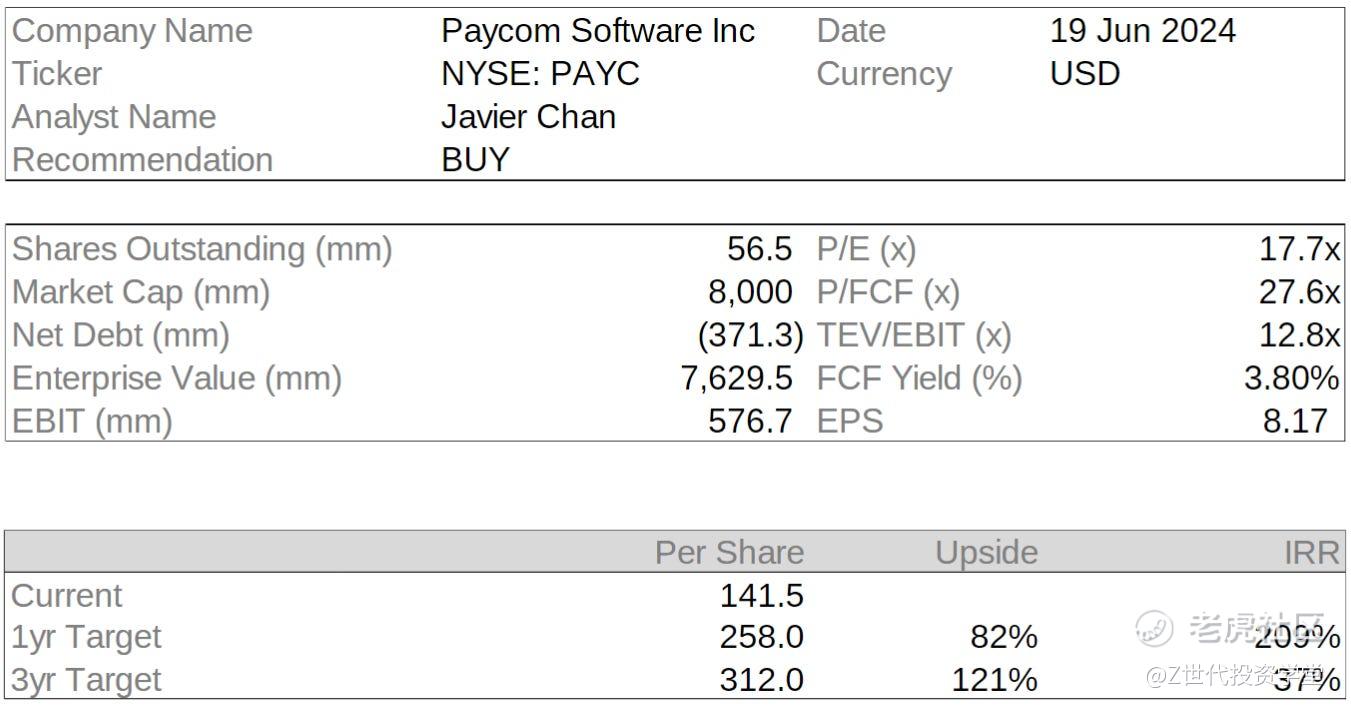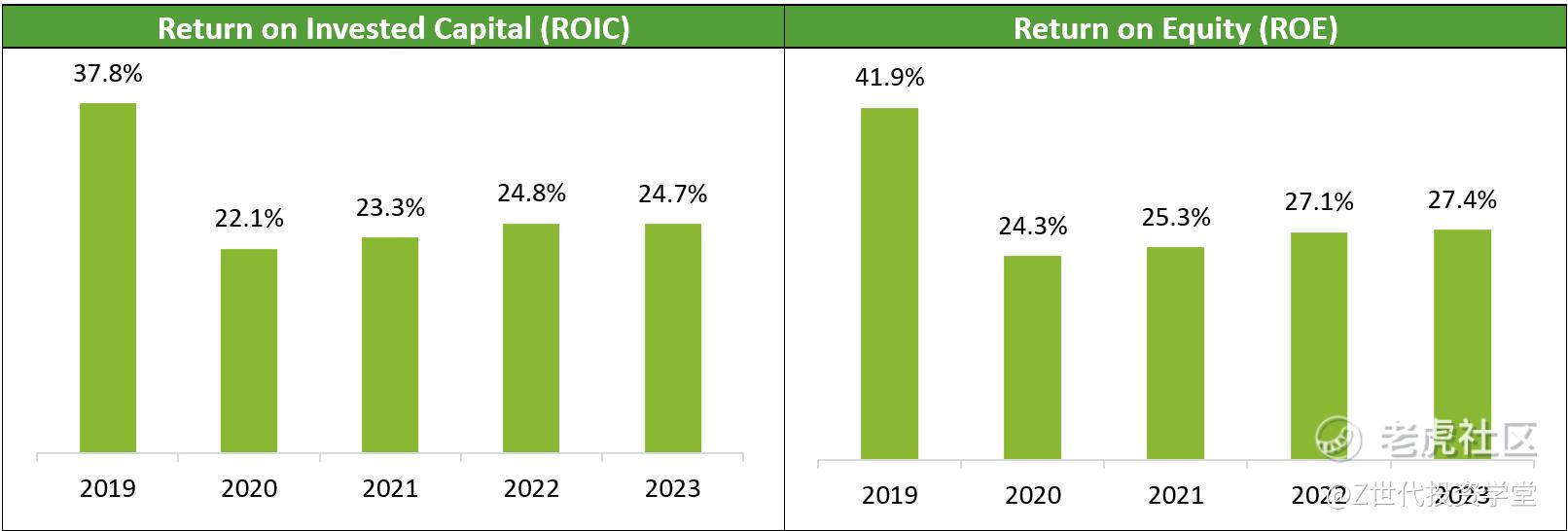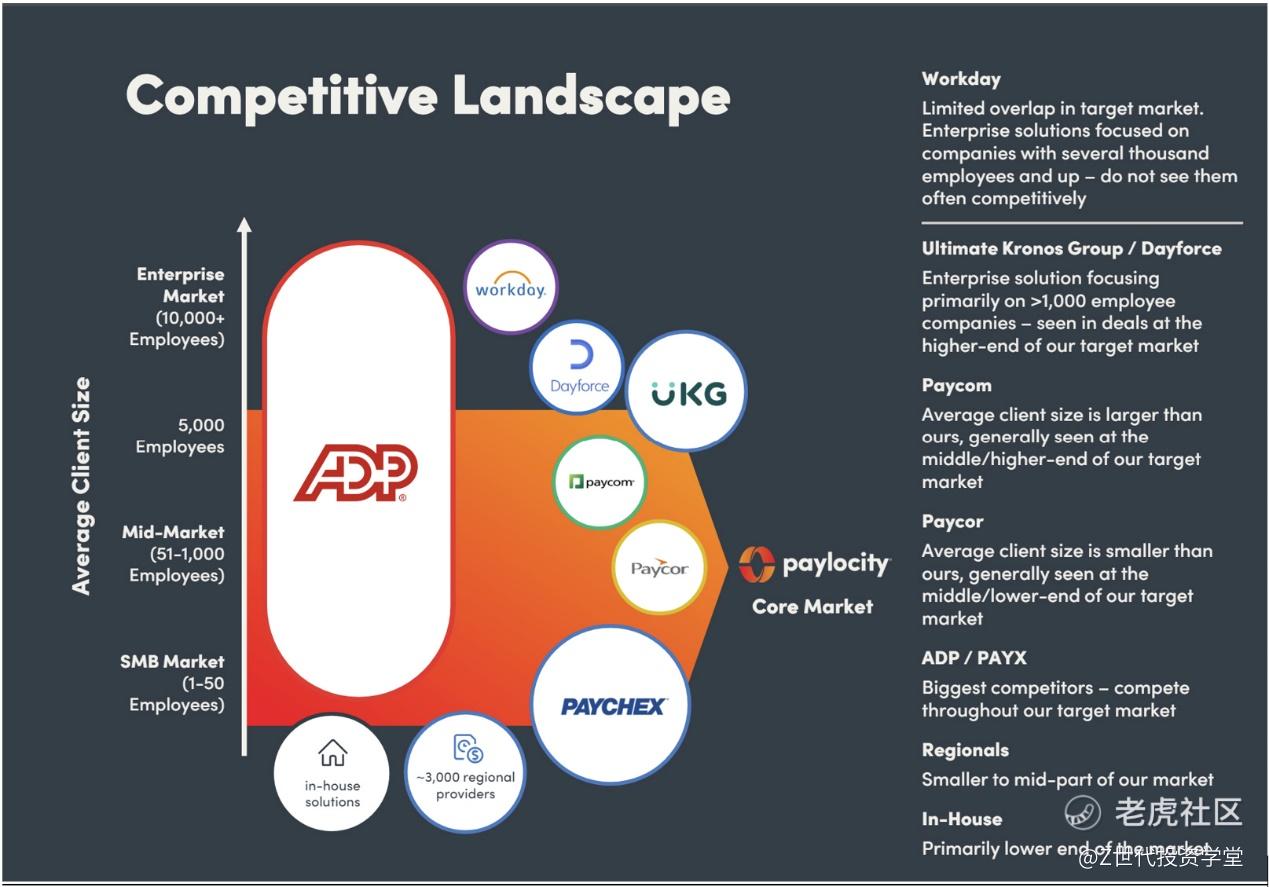Initial Report(part1): Paycom Software Inc (PAYC), 121% 5-Year Potential Upside (VIP, Javier CHAN)
1. Executive Summary I am initiating coverage on Paycom with a BUY recommendation and a 1Y target price of $258 (209% IRR). The setup for Paycom is interesting – the stock is down ~30% YTD, with negative overhang stemming from 2 main issues, (1) revenue cannibalization headwinds, as well as (2) weak client net adds. These issues have introduced uncertainty around Paycom’s future growth, and the street is treating these as structural problems with the business. However, I believe that these are merely temporary headwinds that will soon abate, and we are likely near an inflection point where we will see Paycom return to its structural growth story.
2. Company Overview
Paycom Software, Inc. (“Paycom”) is a leading provider of comprehensive, cloud-based human capital management (HCM) software solutions. Founded in 1998 and headquartered in Oklahoma City, Oklahoma, Paycom has emerged as a prominent player in the HCM industry, serving businesses of all sizes across the United States. The company's innovative software platform offers a unified suite of applications that streamlines and automates various HR processes, including payroll, talent acquisition, time and labor management, and employee engagement, among others. They are focused on the mid to upper-market with an estimated ~7% share of TAM.
Paycom's user-friendly, intuitive software is designed to empower organizations with real-time data and analytics, enabling them to make informed decisions and drive operational efficiencies. The company's commitment to continuous innovation and customer satisfaction has been a driving force behind its success, as evidenced by its consistent recognition as a leader in the HCM space by industry analysts and organizations. With a strong focus on employee experience and a dedication to delivering cutting-edge technology solutions, Paycom has established itself as a trusted partner for businesses seeking to optimize their HR operations and enhance their overall workforce management capabilities.
PAYC Core Platform Offerings
Paycom’s key strength is in providing a single system with deep capabilities across all the above areas. In any company, they may have ADP for payroll, Workday for requesting time off, Concur for expense management, Cornerstone for learning management, etc., but Paycom provides the all-in-one solution. Once employees get accustomed to this workflow, going back to separate providers for different services will feel like a hassle and a downgrade. This creates a sticky, end-to-end ecosystem that becomes deeply entwined into clients’ business operations. Majority of revenues are generated from payroll applications, and payroll usually serves as the first touchpoint with clients before they subsequently cross-sell other modules and features.
Revenue Segments & Recognition
Paycom has 2 reported segments: (1) Recurring Revenues and (2) Implementation and Other Revenues.
Recurring Revenues comprise 98% of sales. Their recurring revenue model is primarily driven by fees charged for its suite of talent acquisition, time and labor management, payroll, talent management, and HR management applications. These fees have two main billing components: (a) fixed amounts charged per billing period and (b) variable per-employee or per-transaction fees. They do not require long-term contracts, and billing periods vary based on client payroll cycles. While undisclosed, assuming the fixed component charged per client is in line with peers at ~$40 per client, this implies that the variable component comprises ~98% of recurring revenue.
Additionally, it also includes (c) interest earned on funds held for clients. They collect funds from clients in advance of either the applicable due date for payroll tax submissions or the applicable disbursement date for employee payment services. These collections from clients are typically disbursed from one to 30 days after receipt, with some funds being held for up to 120 days. Paycom invests these funds in money markets, demand deposit accounts, certificates of deposit and commercial paper until they are paid to the applicable tax or regulatory agencies or to client employees.
Implementation and Other Revenues comprises 2% of sales. This comes from two main sources: (a) one-off set-up fees charged to new clients and existing clients adding incremental applications, and (b) sales of time clocks for their time and attendance services. The implementation fees typically range from 10-30% of the annualized contract value. These fees are recognized as deferred revenue and then amortized over an estimated 10-year client life. Revenues from time clock sales are recognized upon delivery to the client.
Key Operating Metrics
Paycom’s revenue has grown at 23% CAGR from FY19-23, mainly driven by client growth (9% CAGR) and APRU improvements (13% CAGR). Majority of client growth comes from capturing legacy players’ market share, with a smaller portion from greenfield business. ARPU growth mainly comes from the cross-selling of more modules to each client (i.e. onboarding, tax filing, applicant tracking system, and 30+ others), as well as targeting employees with more clients.
Paycom reports an “Annual Revenue Retention Rate” metric that is consistently at or above 90%. On a gross basis, this is considered high, however, Paycom uses a unique methodology to calculate retention, which makes it not directly comparable to other SaaS companies that usually report on a Net Revenue Retention Rate (NRR) basis. Adjusting Paycom’s metric to make it like-for-like, we can see that Paycom’s NRR was 111% in 2023, placing it well above the median of 103% for SaaS companies with high annual contract values (>$25k). Paycom’s competitors are laggards in product stickiness – Paycor had 94% NRR and Paylocity had 92% NRR as of last reported quarter.
The stickiness of Paycom’s products can be attributed to them having a differentiated offering by means of Beti (explained later), and the deep integration of their products into clients’ operations which creates high switching costs. This has allowed them to increase ARPU over time, and has helped them to expand margins through the benefits of operating leverage. Gross margins are stable at about 85% and EBITDA margins have been expanding, now standing north of 42%.
Paycom has an excellent track record with capital allocation. They have been able to invest in growth while achieving a high average ROIC of ~27% and ROE of ~29% over the past 5 years.
3. Industry Overview
TAM
I estimate Paycom’s TAM to be ~$23bn. This is based on the 320,000 establishments and ~94mn employees within Paycom’s target client size (50-1000+ emp.), and a $40 per client and average $20 per employee charge per month. This implies ~7% TAM penetration based on 2023 revenues (mgmt. commentary is ~5%). Experts believe that getting to 15% market share is highly possible. It is worth noting that each competitor defines their TAM slightly different, depending on their positioning and type of client targeted. The global HCM software market is expected to grow between 4-5% CAGR from 2023-2028.
The key drivers of growth of the overall HCM market are:
-
Increasing demand for integrated solutions that combine core HR functions like payroll, talent management, and workforce management into a single platform.
-
The need for data-driven decision-making, with data analytics and automation playing a key role in core HR functions.
-
Adoption of advanced technologies like AI and machine learning to streamline HR processes and enable data-driven decision-making.
The major growth areas are expected to be core HR functions like payroll, talent management, and workforce management, with automation and data-driven decision-making playing a key role.
For Paycom, another major driver of TAM expansion is their move upmarket to target firms with >10,000 employees. This increases average employees per client, which is a tailwind for the variable billing component.
Peer Positioning
Source: Paylocity Q3 FY24 Investor Presentation
Each HCM player targets a slightly different market. Paycom overlaps with Paylocity and Paycor in the bottom markets, but they have recently been trying to punch upmarket to take share from players the like of Dayforce and Workday.
An important industry dynamic to note is that 75-90% of the billings for modern HCM software players come from the displacement of legacy players like ADP and Paychex. ADP and Paychex have an inferior product where the tech is older, and customer service is poor because these companies are too large and inefficient. They barely had any competition for the past 30-40 years, but are now facing disruption from the modern players. The sales pitch for Paycom is much easier when going to ADP/Paychex clients, compared to going to greenfield clients who have no experience with using HCM SaaS/outsourcing, as the objective is just to demonstrate that Paycom’s product is better. Modern HCM companies capturing share from legacy players is a trend that is expected to continue for the next several years.
The HCM space is highly competitive, and historically there has been little product differentiation. Incumbents traditionally competed on sales and marketing/go-to-market strategies and in areas like customer service. Even any differences in the tech were marginal. However, recent developments at Paycom indicate that this dynamic may be about to shift. More on Paycom’s differentiation will be covered below.
*Do note that all of this is for information only and should not be taken as investment advice. If you should choose to invest in any of the stocks, you do so at your own risk.
Disclaimer: Investing carries risk. This is not financial advice. The above content should not be regarded as an offer, recommendation, or solicitation on acquiring or disposing of any financial products, any associated discussions, comments, or posts by author or other users should not be considered as such either. It is solely for general information purpose only, which does not consider your own investment objectives, financial situations or needs. TTM assumes no responsibility or warranty for the accuracy and completeness of the information, investors should do their own research and may seek professional advice before investing.










